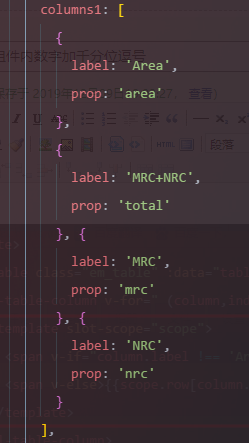父组件:


el-table组件内:

<template> <el-table class="em_table" :data="tableData" stripe :border="true" :size="size"> <el-table-column v-for=" (column,index) in columns " :key="index" :prop="column.prop " :label="column.label "> <template slot-scope="scope"> <span v-if="column.label !== 'Area'">{{formatCurrency(scope.row[column.prop])}}</span> <span v-else>{{scope.row[column.prop]}}</span> </template> </el-table-column> </el-table> </template>
// 逗号分隔数组 formatCurrency (num) { if (num) { // 将num中的$,去掉,将num变成一个纯粹的数据格式字符串 num = num.toString().replace(/$|\,/g, '') // 如果num不是数字,则将num置0,并返回 if (num === '' || isNaN(num)) { return 'Not a Number ! ' } // 如果num是负数,则获取她的符号 var sign = '' if (num.indexOf('-') !== -1) { sign = '-' num = num.substr(1) } // 如果存在小数点,则获取数字的小数部分 var cents = num.indexOf('.') > 0 ? num.substr(num.indexOf('.')) : '' cents = cents.length > 1 ? cents : '' // 注意:这里如果是使用change方法不断的调用,小数是输入不了的 // 获取数字的整数数部分 num = num.indexOf('.') > 0 ? num.substring(0, (num.indexOf('.'))) : num // 如果没有小数点,整数部分不能以0开头 if (cents === '') { if (num.length > 1 && num.substr(0, 1) === '0') { return 'Not a Number ! ' } } else { if (num.length > 1 && num.substr(0, 1) === '0') { return 'Not a Number ! ' } } // 针对整数部分进行格式化处理,这是此方法的核心,也是稍难理解的一个地方,逆向的来思考或者采用简单的事例来实现就容易多了 /* 也可以这样想象,现在有一串数字字符串在你面前,如果让你给他家千分位的逗号的话,你是怎么来思考和操作的? 字符串长度为0/1/2/3时都不用添加 字符串长度大于3的时候,从右往左数,有三位字符就加一个逗号,然后继续往前数,直到不到往前数少于三位字符为止 */ for (var i = 0; i < Math.floor((num.length - (1 + i)) / 3); i++) { num = num.substring(0, num.length - (4 * i + 3)) + ',' + num.substring(num.length - (4 * i + 3)) } // 将数据(符号、整数部分、小数部分)整体组合返回 return sign + num + cents } }